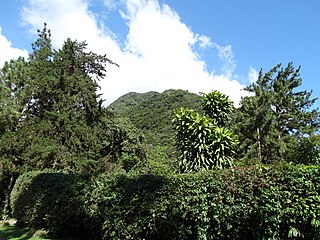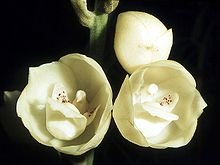
Orchids are plants that belong to the family Orchidaceae, a diverse and widespread group of flowering plants with blooms that are often colourful and fragrant. Orchids are cosmopolitan plants that are found in almost every habitat on Earth except glaciers. The world's richest diversity of orchid genera and species is found in the tropics.

Gongora, abbreviated Gga in horticultural trade, is a member of the orchid family (Orchidaceae). It consists of 65 species known from Central America, Trinidad, and tropical South America, with most species found in Colombia. They grow across a wide geographical range, from wet forests at sea level, to mountainous regions in the Andes, as high as 1,800 m.

Coclé is a province of central Panama on the nation's southern coast. The administrative capital is the city of Penonomé. This province was created by the Act of September 12, 1855 with the title of Department of Coclé during the presidency of Dr. Justo de Arosemena. It became a province, Decretory Number 190, on October 20, 1985. Coclé is primarily an agricultural area, with sugar and tomatoes as major crops. The province has a number of well-known beaches, such as Santa Clara, Farallon and Rio Hato, and tourist activity has increased in recent years. It covers an area of 4,946.6 km2, and had a population of 268,264 in 2023.

Grammatophyllum speciosum, also called giant orchid, tiger orchid, sugar cane orchid or queen of the orchids, is a species of orchid native to Laos, Myanmar, Thailand, Vietnam, Borneo, Indonesia and Malaysia. It has also been recorded in the Philippines, New Guinea and the Solomon Islands. It is listed by the Guinness Book of World Records as the world's tallest orchid, with specimens recorded up to 7.62 metres (25 ft) in height.

The green hermit is a large hummingbird that is a resident breeder from southern Central America south to northern South America

Phragmipedium kovachii is an orchid species found to be new to science in 2001, native to the Andean cloud forests of northern Peru. A species with terrestrial habit and growing in clumps of several individuals, it displays showy pink to purple flowers up to 20 cm (8 in) wide. It is currently considered a critically endangered species by the IUCN, due to overcollection in the wild.

Arundina graminifolia is a species of orchid and the sole accepted species of the genus Arundina. This tropical Asiatic genus extends from Myanmar, India, Sri Lanka, Nepal, Thailand, Vietnam, the Ryukyu Islands, Malaysia, Singapore, China to Indonesia, the Philippines and New Guinea. It has become naturalized in Réunion, Fiji, French Polynesia, Micronesia, the West Indies, Costa Rica, Panama, Belize, and Hawaii. It is also called bamboo orchid.

Maxillaria, abbreviated as Max in the horticultural trade, is a large genus of orchids. This is a diverse genus, with very different morphological forms. Their characteristics can vary widely. They are commonly called spider orchids, flame orchids or tiger orchids. Their scientific name is derived from the Latin word maxilla, meaning jawbone, reflecting on the column and the base of the lip of some species, that may evoke a protruding jaw.

Peristeria is a genus of plants of the family Orchidaceae commonly called dove orchid or Holy Ghost orchid. In line with the common name, the genus' name is from the Greek word peristerion meaning "from dove". According to the Royal Horticultural Society, Per is the official orchid abbreviation for this genus. In nature, it is found across much of South America as well as in Panama, Costa Rica and Trinidad.

The ornamental orchid species Phalaenopsis hieroglyphica is native to certain islands of the Philippines. Its flowers are creamy white with transverse markings that resemble glyphs. Through hybridization, growers have successfully created flowers with different shapes and colors while retaining the glyphs. Since 1975, the species has been protected under Appendix II of the Convention on International Trade in Endangered Species of Wild Fauna and Flora (CITES).

Coeliopsidinae is an orchid subtribe in the tribe Cymbidieae. The three members of this subtribe have traditionally been lumped in with Stanhopeinae, but obvious morphological traits and new molecular analysis by Whitten et al. in 2000 confirmed the group reclassified by Szlachetko (1995).

Pericopsis elata is a species of flowering plant in the family Fabaceae and is known by the common names African teak, afromosia, afrormosia, kokrodua and assamela.

Bifrenaria, abbreviated Bif. in horticultural trade, is a genus of plants in family Orchidaceae. It contains 20 species found in Panama, Trinidad and South America. There are no known uses for them, but their abundant, and at first glance artificial, flowers, make them favorites of orchid growers.
Trigonidium, abbreviated as Trgdm in horticultural trade, was a formerly accepted genus of orchids comprising roughly twenty species found from Mexico to Brazil. As of 2023, it was considered a synonym of Maxillaria.

El Valle de Antón, generally called El Valle, or Anton's Valley in English, is a town of 7,600 in the Coclé province of Panama.

Lycaste aromatica, common name the sweet scented lycaste, is a species of flowering plant in the genus Lycaste of the family Orchidaceae.

Restrepia guttulata, commonly called the small-spotted restrepia, is a species of orchid occurring from Venezuela to Ecuador.
Espiritu Santo is the largest island in the nation of Vanuatu.

Microcoelia exilis, commonly known as the pinhead orchid, is a species of flowering plant in the orchid family, Orchidaceae. It is a leafless epiphyte, a perennial herb that grows in a tangled cluster of roots and stems on the branch of a tree. This orchid is native to tropical central and eastern Africa and was first described in 1830 by the English botanist John Lindley.

Stelis gracilis is a species of leach orchid, which is one of the largest genera in the orchid family, with over 600 species. Stelis gracilis are small epiphytes with greenish-white flowers in raceme inflorescences. This rare species of orchid is found in tropical rainforests in North and Central America. It was first described by the American botanist Oakes Ames in 1908.


















